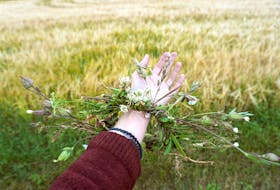The opening lines of the Irving Berlin song “The Easter Parade” will bring back fond memories for many people In Cape Breton.
“In your Easter bonnet, with all the frills upon it,
You’ll be the grandest lady in the Easter parade.”
This song was published in 1933 but I bet that many of us can still sing the lyrics that we heard in our childhood.
In Cape Breton, the weather in April is usually not conducive to wearing Easter bonnets. We are more likely to be wearing a woolen toque or a raincoat.
The Easter celebrations of my youth meant attending Good Friday services and Easter mass at Saint Eugene’s Church in Dominion.
Easter is a religious holiday for people who honour the Resurrection of Christ. This year, Easter celebrations are cancelled in churches but all around the world, people will find ways to mark the occasion.
Unlike many other holidays, the date for Easter changes every year. Easter occurs on the first Sunday after the first full moon or after the vernal equinox.
In 2020, the first full moon is April 8, so Easter is April 12, the first Sunday after the full moon. If the full moon happens to fall on a Sunday, Easter will be the next Sunday.
Many families in Cape Breton serve ham at Easter just like turkey is the traditional Christmas meal.
Why ham? In ancient times, hunters slaughtered wild hogs in the forest in the fall season and they were left to cure over the winter months. In the spring, the ham was ready for the Easter feast.
Another food that is traditional Easter fare is hot cross buns. The origins of this sweet treat goes back to the 12th century. According to ancient folklore, an Anglican monk baked sweet buns and marked them with a cross of icing to honour Good Friday. To this day, these foods are symbols of Easter in many homes.
The Easter bunny is a symbol of Easter that originated in Germany. The Easter hare decided whether children were good or disobedient. He brought goodies to the children who were obedient.
Reminds me of when my children were young and the threat was that Santa was watching and expected everyone to be on their best behaviour.
I can remember getting a skipping rope and a chocolate bunny for Easter. On a good year, we were sometimes rewarded with a new outfit. Do young girls even know how to skip anymore in this high-tech world?
Reminiscing about Easter made me wonder what children from earlier days received for Easter.
I had a telephone chat with Sr. Helen Aboud, who was my nutrition professor at Saint Francis Xavier University in Antigonish. She informed me that in her household, they always looked forward to a new outfit and a straw basket of chocolate treats. Easter traditions haven’t changed that much over the years.
Many families have a tradition of dyeing eggs in the days leading up to Easter.
Eggs represent rebirth and new life so they are associated with spring.
According to legend, Mary Magdalene brought a basket of eggs to share with other women at the tomb of Jesus. When they rolled back the stone and found the tomb empty, the eggs turned red to symbolize the blood of Jesus.
Decorating Easter eggs can be a simple or elaborate process. The Ukrainian community has mastered the intricate skill of decorating Easter eggs. Pysanky eggs are hand-drawn works of art using a wax-resistant method.
When I taught family studies at Glace Bay High School, Easter was an exciting time for my students. The librarian, Corrine Stevenson, would teach my class the intricate art of creating Pysanky eggs. The process taught the students patience, work ethic and creativity. What a wonderful rite of passage for spring.
I’m sure there are many Cape Breton children wondering if the Easter bunny will be delivering Easter treats during this COVID-19 crisis.
According to the words of Nova Scotia’s chief public health officer, Dr. Robert Strang … “Fortunately, the Easter bunny is an expert at social distancing and has been practising good paw-washing since he was just a young bunny. This Easter egg hunt may be a little different but I’m sure that we will all be able to find ways to make it fun.”
Such comforting words to our children from a man who has the weight of the world on his shoulders.
After this brutal Cape Breton winter, many of us are anxiously awaiting the arrival of spring weather. Easter means that the warm weather is on the way.
The snow will soon be replaced by mud puddles, crocuses will be popping up in our yards, dandelions will be blooming on our lawns and the potholes in Reserve Mines will get bigger and bigger. We will still be social-distancing to get through this crisis.
Cape Bretoners are ready for spring .... bring it on!
Yvonne Kennedy is a retired family studies teacher and a member of the Homeville Women’s Institute. She lives in Homeville and can be contacted at [email protected].








